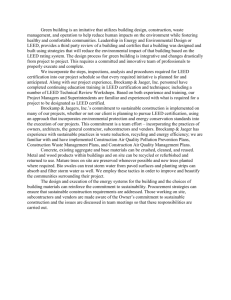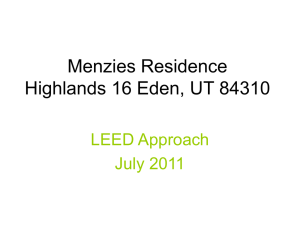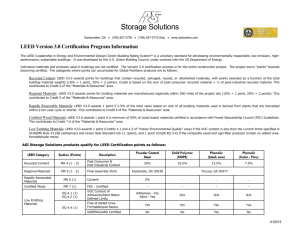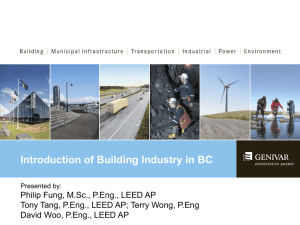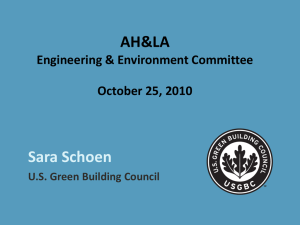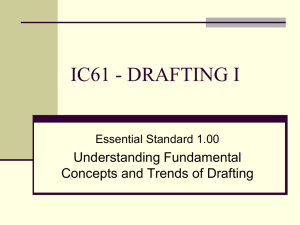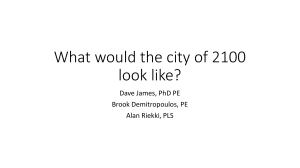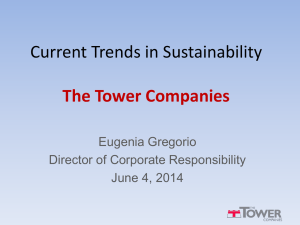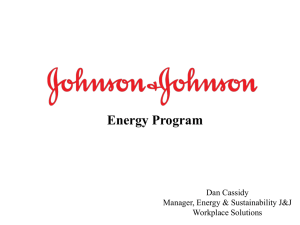Family Health Partnership Clinic Crystal Lake, IL
advertisement
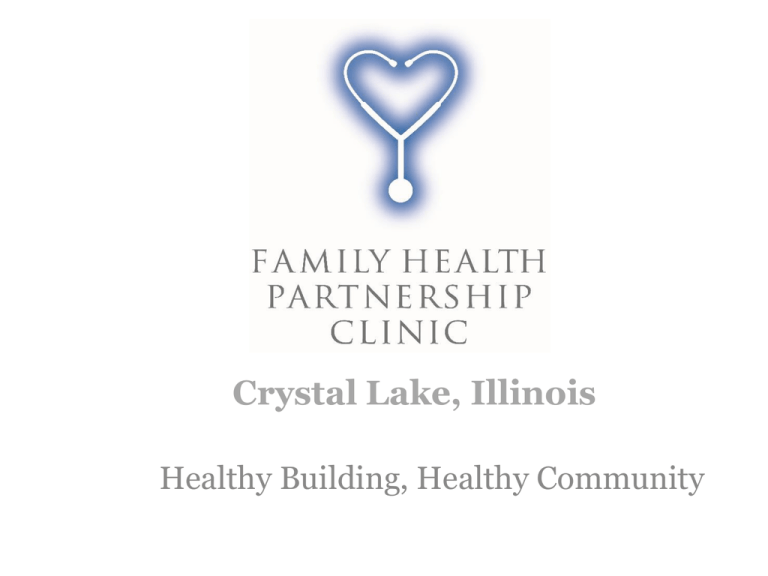
Crystal Lake, Illinois Healthy Building, Healthy Community Why Build Green? Environmental Benefits - Green building practices can substantially reduce or eliminate negative environmental impacts through innovative design, conscientious construction methods and quality operational practices. Health Benefits - Green building practices can increase workers’ productivity, create a positive environment for all building occupants and reduce potential liability resulting from indoor air quality problems. Economic Benefits - Green building practices can reduce operations and management costs, and enhance the building’s marketability. Family Health Partnership Clinic Sage Center for Care Building Green The Family Health Partnership Clinic’s new facility was designed and built with an emphasis on sustainability with the ultimate dual goals of reducing our impact on the environment as well as providing an environmentally healthy clinic for our patients to receive care. This building was unusual in that it was part of a Planned Unit Development (PUD) and thus quite restrictive in what design elements could be implemented externally, but interior features, building materials and construction practices have allowed us to seek Silver LEED Certification as awarded by the United States Green Building Council (USGBC) for New Construction. What is LEED? Leadership in Energy, Environment & Design LEED Certification is voluntarily undertaken by a building’s Owner. The LEED Green Building Rating System is organized into five basic environmental categories: Sustainable Sites, Water Efficiency, Energy & Atmosphere, Materials & Resources and Indoor Environmental Quality. Two additional categories are Innovation and Design Process and Regional Priority. Each category has a variety of credits with points allocated based on potential environmental impacts and human benefits. There are potentially 100 points available. A minimum of 40 points is needed for Certification, 50 for Silver, 60 for Gold and 80 for Platinum Certification. The Family Health Partnership Clinic was awarded over 50 points in all seven categories. The following are examples of Credits obtained in each of the categories. Category 1: Sustainable Sites SS LEED Credit 1 – Site Selection SS LEED Credit 2 – Development Density & Community Connectivity SS LEED Credit 4.1 – Public Transportation Access SS LEED Credit 4.4 – Parking Capacity SS LEED Credit 8 – Light Pollution Reduction The location of a building can have an impact on the environment. The Clinic chose its site based on its proximity to public transportation and its location with respect to pedestrian access to other community amenities. The building is located within a ½ walking distance to both the Metra commuter train station and ten basic services such as a grocery store, bank, post office, pharmacy, etc. – all reducing the impact of automobile use. The building is constructed on a previously developed site and did not need to provide any additional parking, again reducing pollution and developmental impacts from automobile use. The Clinic also worked to reduce light pollution in the night sky through the use of innovative outdoor lighting reducing the negative impact on nocturnal environments. (Photo here) Category 2: Water Efficiency WE LEED Prerequisite Water is a natural resource that must be conserved, particularly in the McHenry Country where groundwater is relied upon. The Clinic achieved a 20% reduction in water use through reduced flow plumbing fixtures. Category 3: Energy and Atmosphere EA LEED Credit 1 – Optimize Energy EA LEED Credit 5 – Measurement and Verification EA LEED Credit 6 – Green Power The Clinic undertook the development of a computerized Whole Building Energy Simulation in an effort to optimize energy and reduce excessive and costly energy use. The entire building envelope including roof, walls, windows, floor, insulation, and the mechanical, electrical and plumbing (MEP) systems were calculated against an energy usage baseline to demonstrate an improvement in the proposed building performance compared with a baseline building performance. The Clinic incorporated several energy design features into the building. High efficient heating and cooling systems, regular energy monitoring as well as purchasing Green Power credits from a local utility company ensure that energy is optimized, and will enable to the Clinic to save energy costs in the future. Materials and Resource – MR LEED Credit 2 – Construction Waste Management – This LEED credit is designed to maximize recycling of construction waster materials, and minimize waste going into the landfill. The graph below shows the progression of materials diverted and recycled. Category 5: Indoor Environmental Quality IEQ LEED Credit 4.1, 4.2, 4.3 Low Emitting Materials IEQ LEED Credit 5 – Indoor Chemical & Pollution Control IEQ Credit 6.1 – Controllability of Lighting IEQ Credit 8.2 – Daylight & Views Building materials including low VOC paints, sealants and carpeting were used to construct the building to minimize indoor air pollution. These materials create a healthier environment for patients, staff and volunteers. 10’ long walk off mats were installed at each entrance to help eliminate excessive dust and dirt from entering the building and contaminating the air quality. Lighting is controlled with automatic room sensors and individual controls to eliminate unnecessary electrical use when space is not occupied. Enhanced views to the exterior with an abundance of natural daylight create a friendly environment and reduce the need for additional lighting and energy use. Category 6: Innovation and Design Process LEED Credit 1.2 – Green Housekeeping By choosing products approved by the EPA with a certain percentage of recycled content, the Clinic helps provide a market for recycled products, and reduces the need for virgin material. Available online, these products do not cost much more than non-recycled content products. The cleaning products are chosen based on impact to the environment in use and disposal. Additionally, the Clinic has contracted with a janitorial service with dedicated green cleaning methods and sustainable equipment to maintain the building. Category 7: Regional Priority RP Credit 1.1 – Site Selection RP Credit 1.2 – Parking Capacity Additional points were awarded to the Clinic based on geographically specific environmental priorities such as Site Selection and Parking Capacity.
